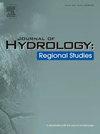巴西南部土地利用变化和降水变率的水文响应
IF 5
2区 地球科学
Q1 WATER RESOURCES
引用次数: 0
摘要
研究区域巴西南部乌拉圭河流域经向高原研究重点研究巴西南部乌拉圭河流域经向高原地区降雨和LULC变化对河流流量变化的相对影响。我们利用MapBiomas的年度LULC数据集和CAMELS-BR数据集,将1985 - 2018年各测量站的日观测数据(降雨量和流量)与年度指数进行汇总。我们通过无监督机器学习算法对三个已识别的集群和78个测量站进行了时间序列和趋势分析。我们发现大豆农田在从其他临时作物(如玉米、小麦、燕麦等)过渡后出现了广泛的、统计上显著的农业扩张,这伴随着统计上显著的径流系数下降(即34% %),而降雨和流量的结果在统计上不显著。此外,我们观察到与大豆农田扩张相关的需水量增加了27% %,这一现象得到了现有研究的证实。水坝数量和容量的增长可能会在分析期间进一步强化这些发现。因此,径流系数的显著下降可能主要归因于土地利用储量的变化。我们的研究结果可能为改善水资源管理提供见解,为未来的土地利用规划提供见解,以开发更具弹性的集水区,以应对不断变化的环境和气候条件。本文章由计算机程序翻译,如有差异,请以英文原文为准。
Hydrological responses to land use changes and precipitation variability in Southern Brazil
Study region
Meridional plateau, Uruguay River Basin, Southern Brazil
Study focus
This study investigates the relative impacts of rainfall and LULC changes on streamflow variations over the Meridional plateau in the region comprising the Uruguay River basin in Southern Brazil. We used MapBiomas annual LULC data set and the CAMELS-BR data set by aggregating daily observations from gauging stations (rainfall and streamflow) to annual indices from 1985 to 2018. We employed time series and trend analysis across three identified clusters with 78 gauging stations through an unsupervised machine learning algorithm.
New hydrological insights for the regions
We found an extensive and statistically significant agricultural expansion for soybean croplands following a transition from other temporary crops (i.e., maize, wheat, oats, etc.), which was accompanied by statistically significant runoff coefficient decrease (i.e., 34 %), while the results for rainfall and flow were statistically insignificant. Furthermore, we observed a 27 % rise in water demand linked to the expansion of soybean croplands, a phenomenon corroborated by existing research. The growth in the number and capacity of dams further may reinforce these findings across the analyzed periods. The identified remarkable decrease in runoff coefficient may, therefore, be primarily attributed to LULC changes. Our findings might provide insights for improved water resource management for future land use planning to develop more resilient catchments against changing environmental and climatic conditions.
求助全文
通过发布文献求助,成功后即可免费获取论文全文。
去求助
来源期刊

Journal of Hydrology-Regional Studies
Earth and Planetary Sciences-Earth and Planetary Sciences (miscellaneous)
CiteScore
6.70
自引率
8.50%
发文量
284
审稿时长
60 days
期刊介绍:
Journal of Hydrology: Regional Studies publishes original research papers enhancing the science of hydrology and aiming at region-specific problems, past and future conditions, analysis, review and solutions. The journal particularly welcomes research papers that deliver new insights into region-specific hydrological processes and responses to changing conditions, as well as contributions that incorporate interdisciplinarity and translational science.
 求助内容:
求助内容: 应助结果提醒方式:
应助结果提醒方式:


